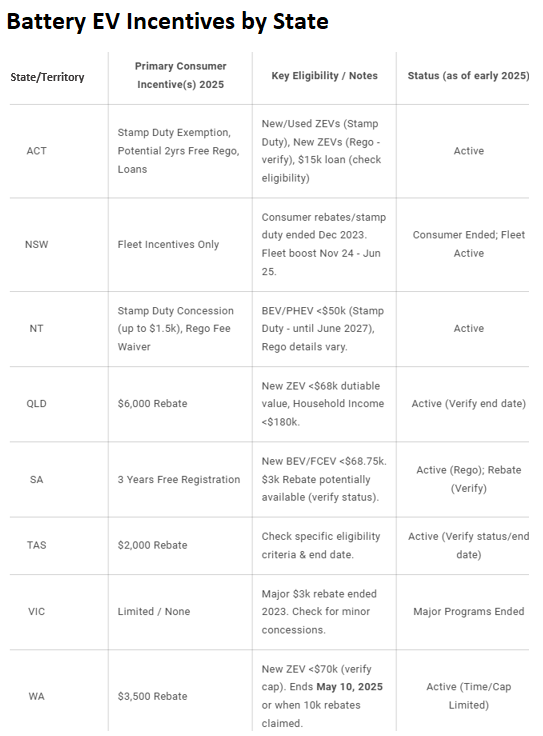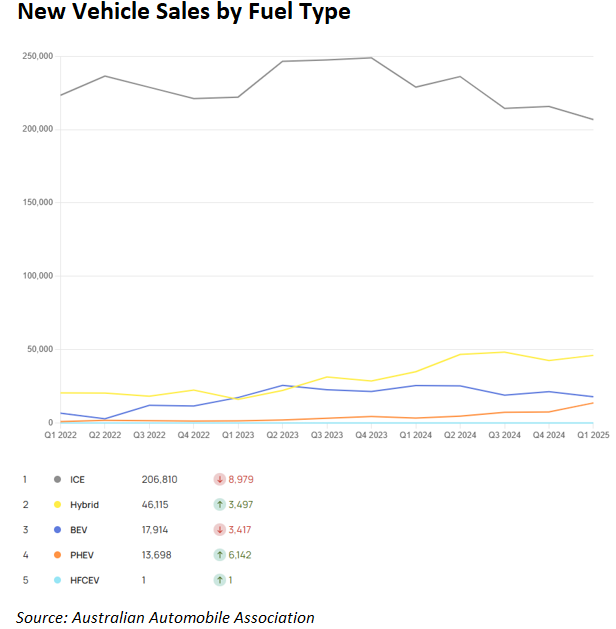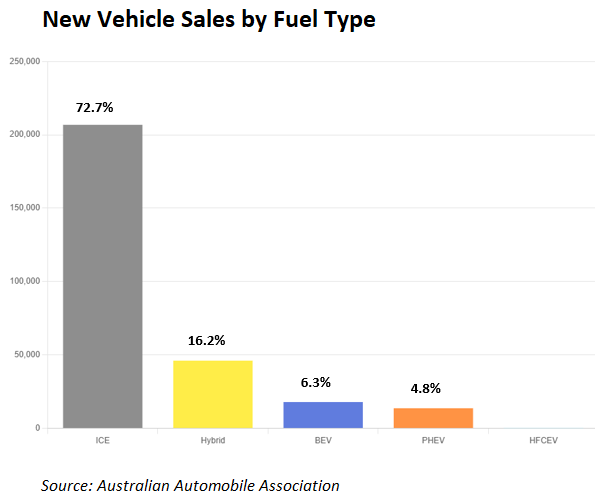Battery electric vehicles (BEVs) are massively subsidised in Australia.
The Fringe Benefits Tax (FBT) exemption for BEVs costs the federal government more than $500 million in lost tax revenue each year—a figure that will increase alongside the take-up of BEVs.
Under the FBT exemption, somebody leasing a $60,000 car can save more than $12,000 per year if they opt for a BEV over an internal combustion engine (ICE) or hybrid.
BEVs qualify for a higher luxury car tax threshold than ICE vehicles.
Various Australian states and territories provide direct subsidies, stamp duty exemptions, and registration discounts for BEVs:

Finally, and most importantly, BEVs are currently excluded from road user charges via the fuel excise rate of 50.8 cents per litre.
However, the free ride for BEVs looks to be coming to an end.
The Productivity Commission (PC) has already recommended that the federal government phase out the FBT concession, alongside other subsidies.
A PC report released last week stated that “road infrastructure should be funded through user charges … that reflect the efficient cost of providing and maintaining that infrastructure”.
“By giving drivers a clear signal about the cost of infrastructure, they would have an incentive to use it more efficiently”, the report said.
Former Victorian Treasurer Tim Pallas told The Australian that BEVs were “heavier and do more damage to the road network as a consequence than do internal combustion engine vehicles”.
He said that BEVs were receiving a “very substantial free ride as it were in terms of the maintenance and management of the road network”.
State and territory governments have also slowly been phasing out direct subsidies and discounts.
Federal Treasurer Jim Chalmers is also being encouraged to implement a distance-based road user charge for BEVs to bring them into line with fuel excise charged on ICE vehicles.
“Infrastructure Partnerships Australia – which is chaired by Rod Eddington, who is close to Anthony Albanese – is calling for a distance-based charge on EVs”, the Australian reported.
“The New Zealand government moved ahead of Australia last week, unveiling plans for all light vehicles, including electric, hybrid, petrol and diesel, to pay for road use based on distance travelled and vehicle weight instead of fuel excise”.
“Chalmers, who recently discussed the road-user charge with Transurban board members, has signalled he will pursue the tax reform in Labor’s second term”.
“Speaking at the National Press Club in June, Dr Chalmers said he was working “with states and territories on the future of road-user charging”.
Without taxpayer subsidies and financial incentives, BEV sales would likely crash. Australians overwhelmingly prefer the convenience of ICE and hybrid vehicles.
The latest quarterly data from the Australian Automobiles Association showed that quarterly BEV sales (blue line) peaked in Q2 2023 at 25,696 and were 30.3% lower in Q1 2025:

Over the same period, hybrid sales (yellow and orange lines) soared and combined roughly tripled BEV sales.
BEVs’ share of total car sales was only 6.3% in Q1 2025, down from 8.7% at the peak in Q2 2023. By contrast, ICE vehicles comprised 72.7% of total sales, standard hybrids 16.2%, and PHEVs 4.8% (hybrids combined 21%).

The latest data is also discouraging. In the year to July, BEV sales totalled just 54,364 in Australia, down from the 2024 total over the first 7 months of 57,648.
Australia’s governments should stop wasting taxpayers’ money and destroying their budgets by subsidising the purchase and use of BEVs.
There are many better ways to spend scarce taxpayer funds than subsidising private car purchases. Doing so is wasteful and inequitable.

